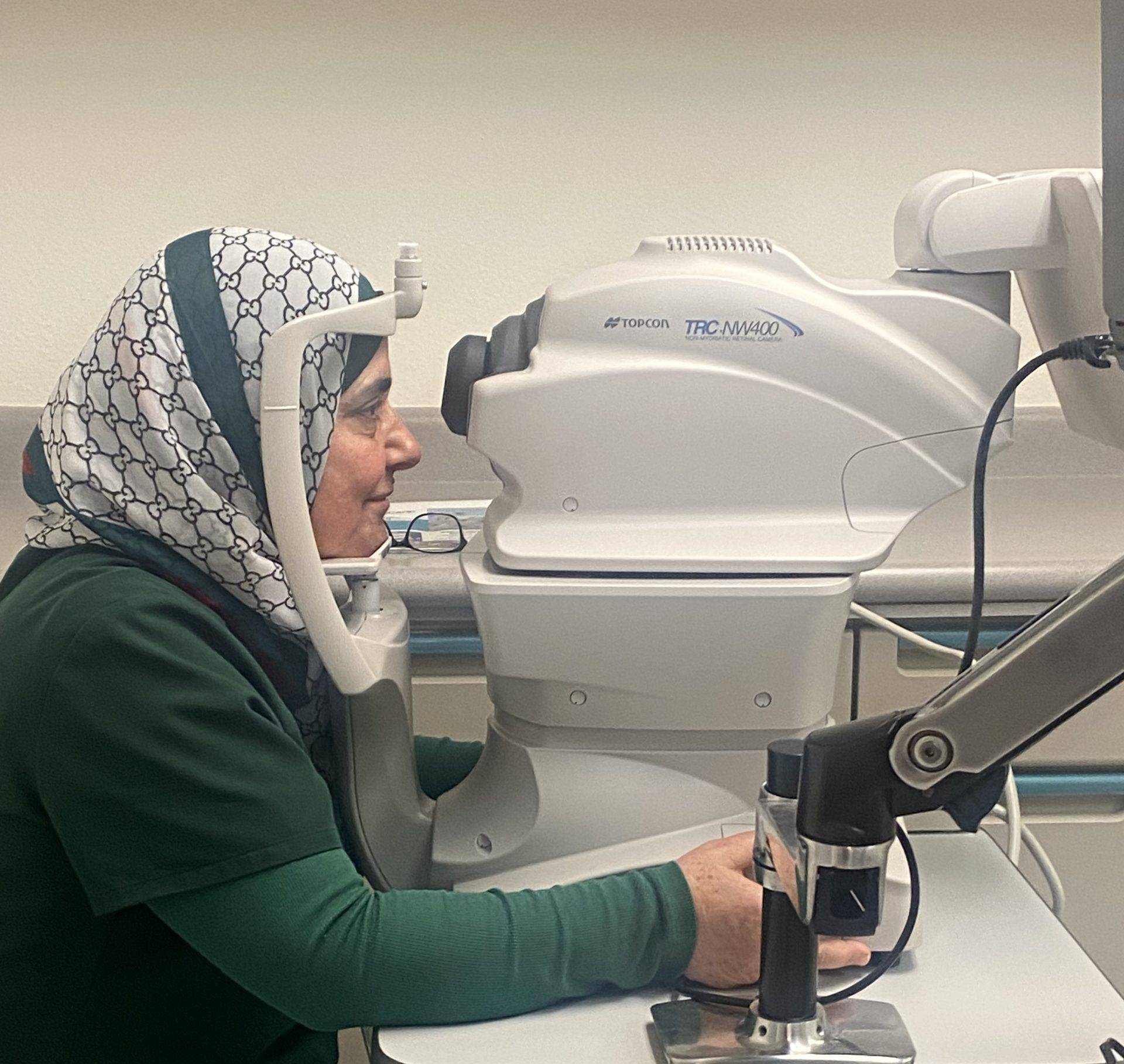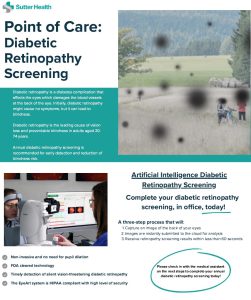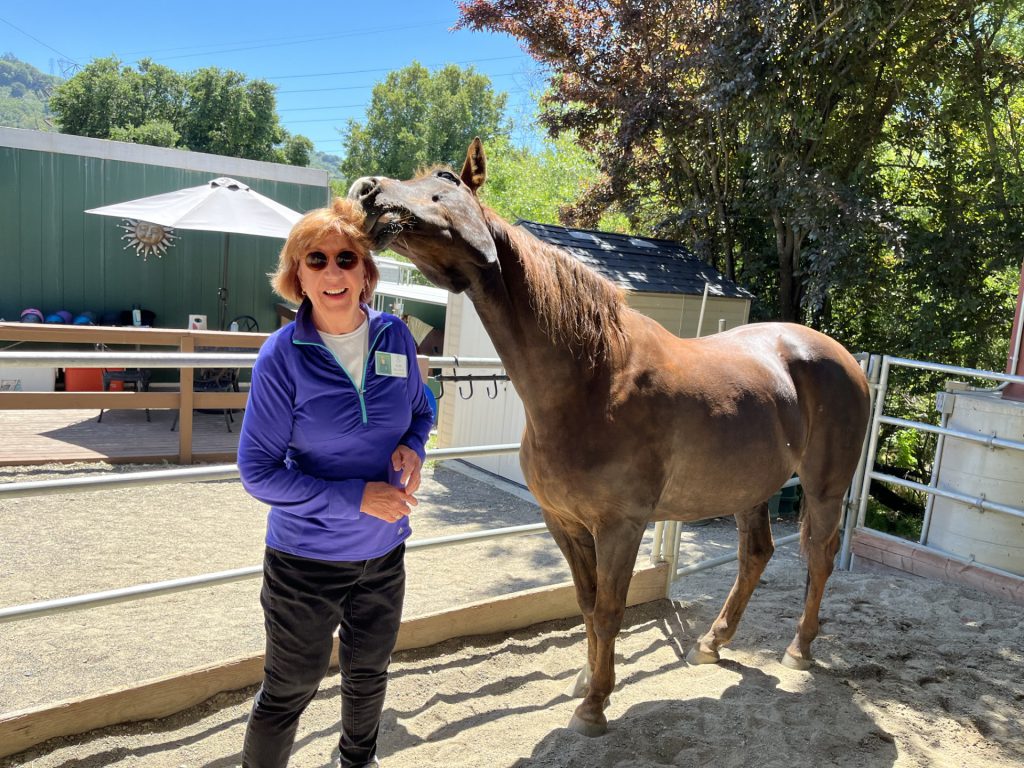New sight-saving AI-enhanced technology now available in 28 Sutter primary care offices; more sites planned for 2025.
The American Diabetes Association recommends that people with diabetes receive an annual eye exam to screen for diabetic retinopathy – the leading cause of blindness in the U.S. among working age adults. Yet, national figures indicate that only slightly more than half of those who should be screened each year have this done. In historically marginalized communities the screening rate is even lower.
Doctors and nurses have been working to address this problem for the past 20 years. As the popularity and power of Artificial Intelligence grows, many of those same providers are asking if the solution to improved screening rates is finally within sight.
A History of Imperfect Options
Initially the only way people with diabetes could get screened for diabetic retinopathy was during an eye exam done by an Optometrist or Ophthalmologist. But going, in-person, to an eye specialist proved a challenge for many.
“In the traditional exam your eyes are dilated, so the need to return to work held a lot of people back,” explains Paul McFall, director of quality and patient safety at Sutter Health. Eye specialists are concentrated in cities, presenting a transportation barrier for patients from rural areas. Add in appointment scarcity, unpredictable insurance coverage, language or cultural barriers, and the unknowns inherent in seeing a new provider (especially a ‘specialist’) and it’s easy to see why many patients never made it to an appointment.
Then, more than a decade ago, advancements in photography and investments in telemedicine seeded a new option. Easy-to-use cameras could now produce high quality images of a patient’s retina, without the need for pupil dilation. Many in the medical community believed that putting these so-called ‘retinal cameras’ in primary care offices, where people with diabetes are seen at least annually for a check-up, would close the retinopathy screening gap.
The technology was tried in clinics across the country, including a Sutter pilot in 2018 at one site in the Central Valley and another in September 2022 at three sites in the Bay Area. Overall, the numerous pilots proved that convenient ‘point of care’ cameras caught more retinopathy than would have been detected without them. But regular use of the cameras remained low and broad adoption stalled. Dr. David Kerr, a Sutter expert on the role of technology and digital health in diabetes care, says the core issue came down to time.
“Until very recently there’s been no substitute for the skill of an eye specialist – so only Optometrists or Ophthalmologists could diagnose and grade retinopathy either by looking at an image taken in primary care or by looking at a patient sitting in front of them,” says Dr. Kerr. “But relying on these professionals meant primary care practices had to wait up to three days for a screening result.”
When the result was positive, primary care staff had to reach back out to the patient to refer them to treatment – which is far less ideal than making the referral while a patient is still in the office. When the result was inconclusive the administrative burden to have patients return to the office for a new photo was even greater. Added to these workflow challenges was low reimbursement for the eye specialist’s professional fee – often leaving primary care providers to pay the difference or risk losing Ophthalmologists’ participation.
AI Enters the Picture
Fast forward a few years and Artificial Intelligence, or AI, can now detect even the earliest signs of retinopathy present in a retinal image, in under 60 seconds. Moreover, studies have shown that computers are as accurate as humans at this type of ‘pattern recognition’ and are able to ‘grade’ findings as normal, mild, more than mild, or sight threatening.
A new era of screening has arrived, but will real-time results from AI finally lead to widespread scale of retinal cameras in primary care? And will medical staff use the cameras consistently now that delayed referrals, missed communication, and increased follow-up work are no longer concerns?
To get answers Sutter enthusiastically embarked on another pilot in June 2024, this time using retinal cameras with FDA-cleared AI technology at six sites. Uniquely, the pilot allocated research resources to an additional question: by removing barriers of access and transportation that disproportionately burden some patients, could AI-enhanced point of care retinal cameras decrease disparities in diabetic retinopathy screening rates?
AI is Put to the Test
“We leapt at the chance to bring a health equity lens to this pilot,” says Dr. Andy Brothers, Sutter family medicine physician and co-chair of the Physician and Advanced Practice Clinician Ambassador Council, within Sutter’s Institute for Advancing Health Equity. “We centered the study on patients who’ve historically had a disproportionate burden of illness and unequal access to healthcare, instead of attempting to ask if the solution works for ‘everyone’ only to find out years later that it doesn’t work for the groups most at risk.”
Family nurse practitioner Irene Arroyo-Romero agreed, saying “from the outset we conditioned the success of this solution on how well it served patients who identify as Latino or Hispanic, that’s nothing short of revolutionary.”
Pilot sites were chosen so cities of different size would be included in the sample. Dr. Brothers’ clinic in Sacramento was an intentional choice because approximately 15% of patients treated there are insured through MediCal (California’s Medicaid program). And Arroyo-Romero was selected to lead the equity-focused research given her position as Sutter’s inaugural Health Equity Nursing Fellow – a title that came with access to mentors and resources from Sutter’s IAHE. The fellowship is part of a formal partnership between Sutter and Samuel Merritt University’s Ethnic Health Institute and Doctor of Nursing Practice program.
Arroyo-Romero, with the support of her IAHE mentor and colleagues within Sutter’s research, nursing and quality teams, developed many of the pilot’s parameters, including how patients would be identified for screening, what education they would receive, and the type of data that would be collected to measure impact. During the 90-day pilot 216 patients were screened and 24 were found to have retinopathy (15 sight threatening, 9 more than mild).
Perhaps the most notable finding from the study was that nearly half of all patients screened self-identified as either Hispanic/Latino or Black. “This was so impressive and important to our group because we know that racial minorities are typically underrepresented in research, with participation rates often falling well below their proportion in the general population,” says Dr. Brothers. The pilot concluded that AI-enhanced retinal cameras, used in primary care, could likely help decrease racial disparities in diabetic retinopathy screening rates.
Answers to the pilot’s other questions also came swiftly. Before the pilot concluded additional sites were already requesting their own cameras and fewer than five months after the pilot ended cameras had been put in 22 more primary care offices across Sutter. Use of the cameras was also shown to be strong, with each of the six sites successfully adapting workflows to offer the screen any patient who was in office (regardless of reason for visit) and needed the test.
A Model for the Future?
“I think this this project proves that health equity isn’t an afterthought at Sutter Health and it’s also a great example of how a relatively small pilot can lead to big change,” says Dr. Kristen M.J. Azar, executive director of Sutter’s IAHE and Arroyo-Romero’s primary mentor for the fellowship. “We demonstrated that it is possible to vet a new technology or process for how well it serves historically marginalized people, before it is broadly rolled out.”
Dr. Azar says that doing this type of upfront health equity-focused, scientifically rigorous quality improvement work is one way Sutter hopes to end future disparities in healthcare. Follow-up work by Sutter’s IAHE may now include testing different outreach strategies to close screening gaps for hard-to-reach patients. The team also plans to evaluate the impact of these devices as they are scaled across the Sutter system, including taking a look at what happens to patients after they are screened and referred to a specialist.
Sutter’s Dr. Kerr is looking at the possibility of using the AI-enhanced retinal cameras to screen for other diseases, including Alzheimer’s and diabetes-related kidney or cardiovascular disease.
An admitted evangelist, Dr. Brothers hopes to work with fellow primary care providers to make the most of the retinopathy screening results, once they’re consistently part of the patient’s chart. “This is new data for us to have and I know it can be used as a prompt, telling us that a patient’s blood pressure or diabetes medication needs to be changed, for example. This is our strength in primary care and this tool is going to make us so much stronger.”






